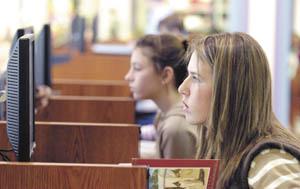Virtual Instruction
Published 12:00 am Wednesday, November 14, 2007

- Hunter Wilson/Daily News Kristen Taulbee, 13, works on an assignment on the computer in Bowling Green Junior High School's library during her Latin class that is taught via television and computer.
Nine Bowling Green Junior High School students moved last week from taking instruction via a TV monitor to working independently at computers in their school library – all in the name of Latin.
More students are being afforded the opportunity to learn “virtually,” making up for what schools lack. Virtual learning provides students educational opportunities not usually available on their campuses.
“It is something used to enhance student learning,” said Tricia Neumann, eighth-grade counselor at the junior high. “It’s something that can create educational opportunities in areas for our students.”
Students link to virtual schools to take advanced placement courses, core courses and to study foreign languages, like the Latin students at Bowling Green Junior High.
“We offer Spanish in the eighth grade, which is taught by the Spanish teacher from the high school,” Neumann said. “Students earn high school credit for the class, but there is only space for one Spanish class.”
With interest from 120 students, test scores, teacher recommendations and grades determined which students would take the Latin class, she said.
“Our principal didn’t want to leave students out of taking a language,” she said. “She wanted to provide an opportunity for more students.”
That opportunity was Latin, taught through Kentucky Educational Television.
For 17 years, KET has combined the Internet, multimedia and personal contact to offer standards-based courses – such as Latin, German, humanities and physics – not otherwise available directly to students. The students learn through lessons on videotape, CD-ROM or DVD, which they apply through interactive activities on the Web site.
“This is a good opportunity for students,” said Scott Wells, facilitator of the Latin course. “If there isn’t enough instructors certified to teach a subject, KET provides for that gap.”
Tuition is based upon the number of students enrolled in a course.
Including humanities courses, 5,200 students are taking courses through KET, said Linda Hafacker, classroom manager for KET.
“Enrollment has been pretty steady,” she said.
While some schools chose to go through KET, some use the offerings of Kentucky Virtual Schools, formerly known as the Kentucky Virtual High School. KYVS offers a range of online, e-learning services to help schools and teachers meet their goals. The courses are taught by state-certified teachers and meet both state and national curriculum standards, said Paula White of KYVS.
By integrating KYVS services, districts, schools and teachers find new ways to provide options for expanded choices to meet gifted and talented students’ needs, increased instructional support for at-risk students and credit recovery.
But at Greenwood High School, the virtual school isn’t used for credit recovery, but to enhance curriculum.
“It provides them the opportunity to take courses not physically offered at the high school,” said Marty Guildie, counselor at the high school. “It helps them pursue current and future goals.
“The courses offered through the virtual Kentucky school are difficult, especially the foreign language courses.”
There is a catch to virtual learning – no teacher. Since virtual learning consists of the Internet and multimedia, the traditional classroom doesn’t exist.
“I miss that interaction,” said Alex Oldham, 13. “It’s fun, but hard without having a real teacher. But this is a good opportunity. It’ll help with vocabulary in later years and with learning other languages.”
Neumann said it is challenging for the students not having a teacher in the room, but she said the instructor is available when needed – which Wells touts as a benefit.
“There’s no real difference. It’s the same pen and paper work,” Wells said. “Students now are used to using technology in almost everything they do. The benefit is the instant feedback.”
Online learning allows students to work at their own pace.
“I like it,” said Michael Crocker, 13. “I can work at my own pace if I need to, and no one is rushing me. The immediate feedback helps me a lot and I can always e-mail the instructor if I need help.
“It’s a really hard class, but it’s worth it.”





